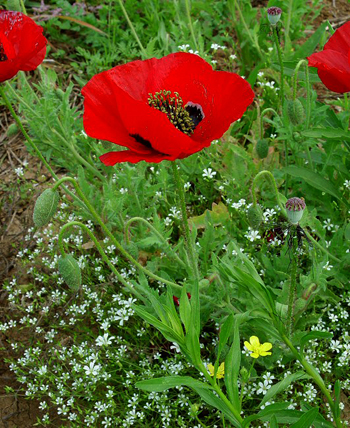Contents:
Common Names | Parts Usually Used | Plant(s) & Culture | Where Found | Medicinal Properties | Biochemical Information
Legends, Myths and Stories | Uses | Formulas or Dosages | Warning | Bibliography
Scientific Names

- Papaver rhoeas L.
- Papaveraceae
- Poppy family
Common Names
- Ahiphena (Sanskrit name)
- Corn poppy
- Flanders poppy
- Ying-su-qaio (Chinese name)
Parts Usually Used
Seeds (non-narcotic), blossoms
Back to Top
Description of Plant(s) and
Culture
Crepe-like flowers appear from late spring onwards and are followed by the distinctive poppy head in which the seeds are stored. The milky juice obtained from this has narcotic properties, though less so than the white poppy from which opium is obtained.
Poppies do not transplant easily. Better to start with seeds, in pots in the northern climates.
Back to Top
Where Found
Grows wild in cornfields, hence its common name ‘corn poppy’. Mostly cultivated.
Back to Top
Medicinal Properties
Astringent, antispasmodic, analgesic, carminative, sedative
Back to Top
Biochemical Information
Alkaloid rhoeadine, no narcotics
Back to Top
Legends, Myths and Stories
In classical mythology this plant was sacred to Ceres.
Back to Top
Uses
The Red Poppy has a long honored reputation as a sedative. It contains a non-poisonous sedative alkaloid called rhoeadine. But, unlike its cousin the “Opium Poppy”, it contains no narcotics. The blossoms and seeds are also added to cough syrups. The flowers are used as a dye in teas, wine and ink.
Leaves and petals are used in a standard infusion on sore throats, cough, and chest congestion, catarrh, hay fever, asthma, dyspepsia, diarrhea, dysentery, insomnia, nerve pain, and other respiratory complaints.
A few crushed poppy heads added to a linseed poultice (1/4 lb. linseed, 1/2 oz. olive oil, both well stirred in one pint of boiling water) will reduce pain and swelling.
Poppy seed used as topping on cookies, breads, rolls; in cake fillings, fruit salads, canapés, and sweet vegetables. (These poppy seeds are not from the opium poppy, Papaver somniferum L.).
Back to Top
Formulas or Dosages
Decoction: 1/4 oz. of poppy seeds simmered in 1 pint of water along with 1 tsp. each of nutmeg and ginger powder and taken 3 times a day immediately after meals for nervous digestion. A cup also taken before sleep to promote rest.
Back to Top
Warning
Caution should be taken in cases of gastritis and colitis.
Back to Top
Bibliography
![]() The Herb Book
The Herb Book, by John Lust, Bantam Books, 666 Fifth Avenue, New York, NY. copyright 1974.
![]() Culpeper’s Complete Herbal & English Physician: Updated With 117 Modern Herbs
Culpeper’s Complete Herbal & English Physician: Updated With 117 Modern Herbs, by Nicholas Culpeper, Meyerbooks, publisher, PO Box 427, Glenwood, Illinois 60425, 1990, (reprint of 1814)
![]() The Nature Doctor: A Manual of Traditional and Complementary Medicine
The Nature Doctor: A Manual of Traditional and Complementary Medicine, by Dr. H.C.A. Vogel; Keats Publishing, Inc., 27 Pine Street (Box 876) New Canaan, CT. 06840-0876. Copyright Verlag A. Vogel, Teufen (AR) Switzerland 1952, 1991
![]() The Yoga of Herbs: An Ayurvedic Guide to Herbal Medicine
The Yoga of Herbs: An Ayurvedic Guide to Herbal Medicine, by Dr. David Frawley & Dr. Vasant Lad, Lotus Press, Twin Lakes, Wisconsin, Second edition, 1988.
![]() Webster’s New World Dictionary
Webster’s New World Dictionary, Third College Edition, Victoria Neufeldt, Editor in Chief, New World Dictionaries: A Division of Simon & Schuster, Inc., 15 Columbus Circle, New York, NY 10023
 The Rodale Herb Book: How to Use, Grow, and Buy Nature’s Miracle Plants (An Organic gardening and farming book)
The Rodale Herb Book: How to Use, Grow, and Buy Nature’s Miracle Plants (An Organic gardening and farming book), edited by William H. Hylton, Rodale Press, Inc. Emmaus, PA, 18049., 1974
